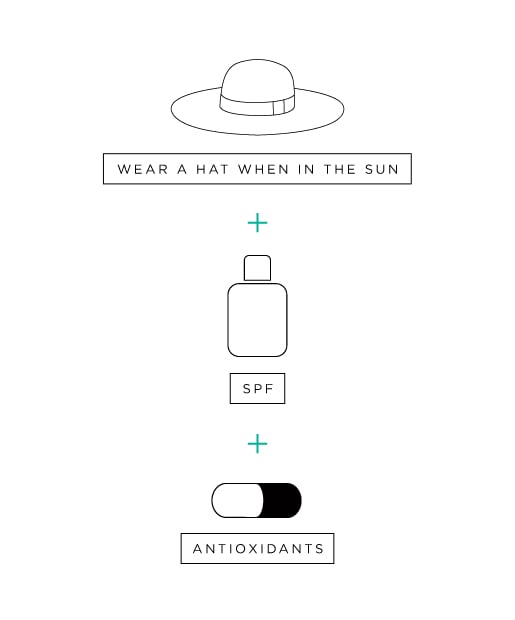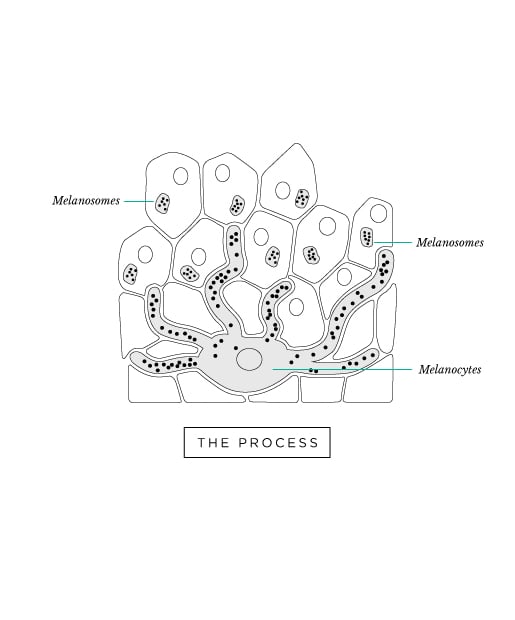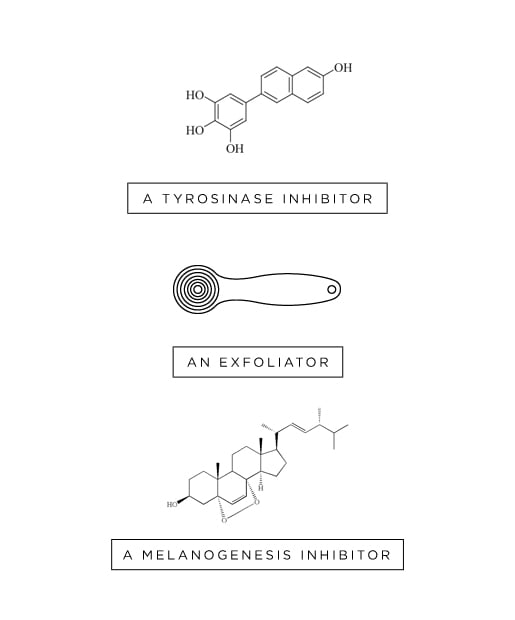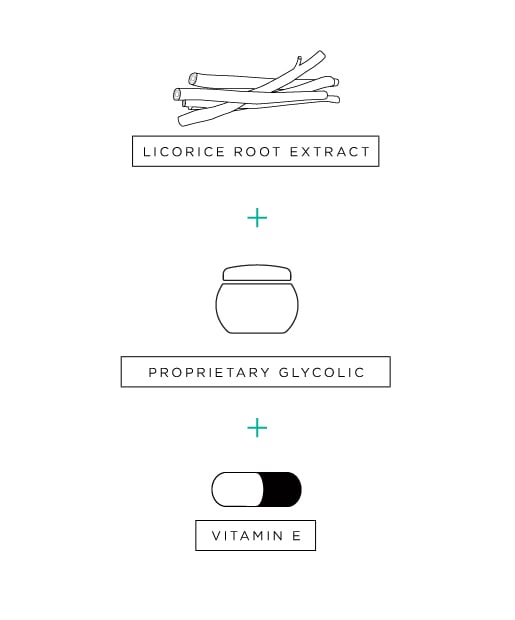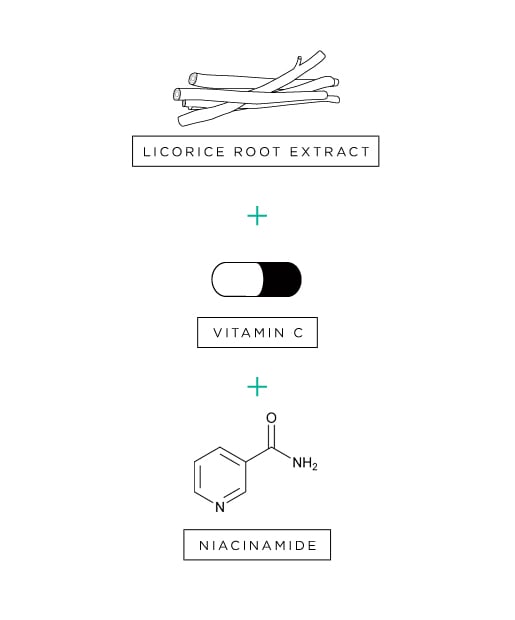It's important to note that combining lifestyle changes with topical skin care products will net the best results in treating hyperpigmentation. The No. 1 mistake Woolery-Lloyd sees patients make when trying to treat hyperpigmentation? "They don't wear sunscreen and or practice sun avoidance. If you don't [protect your skin from the sun], you're fighting an uphill battle," she cautions.
Healing antioxidants can be a great ally in improving sun protection and preventing unwanted melanin production. "An SPF 30 blocks approximately 97 percent of the sun's UVB rays, but topical antioxidants prevent free radical damage from the small percentage of UVB that does enter the skin. Plus, they reduce inflammation, which triggers melanin production and often contributes to dark spots in darker skin types," says Woolery-Lloyd. Look for products that couple antioxidants like Vitamin E with barrier function strengtheners like black bamboo extract, which help build and strengthen skin's natural moisture barrier to lock in hydration.
Woolery-Lloyd also suggests the following tips to enhance results:
- Use a sunscreen with minimum SPF 30, seven days a week, regardless of the forecast.
- Wear a hat when out in the sun.
- Take a supplement with polypodium leucotomos, an antioxidant from a tropical fern that fights melasma and is photo-protective. Woolery-Lloyd also suggests taking a green tea supplement, which "has also been studied, but less extensively."
- Review your medications. Some medications can make hyperpigmentation worse, including oral contraceptives, hormone replacement therapies, topical estrogen creams, some diuretics used to control blood pressure, and some antibiotics.
Healing antioxidants can be a great ally in improving sun protection and preventing unwanted melanin production. "An SPF 30 blocks approximately 97 percent of the sun's UVB rays, but topical antioxidants prevent free radical damage from the small percentage of UVB that does enter the skin. Plus, they reduce inflammation, which triggers melanin production and often contributes to dark spots in darker skin types," says Woolery-Lloyd. Look for products that couple antioxidants like Vitamin E with barrier function strengtheners like black bamboo extract, which help build and strengthen skin's natural moisture barrier to lock in hydration.
Woolery-Lloyd also suggests the following tips to enhance results:
- Use a sunscreen with minimum SPF 30, seven days a week, regardless of the forecast.
- Wear a hat when out in the sun.
- Take a supplement with polypodium leucotomos, an antioxidant from a tropical fern that fights melasma and is photo-protective. Woolery-Lloyd also suggests taking a green tea supplement, which "has also been studied, but less extensively."
- Review your medications. Some medications can make hyperpigmentation worse, including oral contraceptives, hormone replacement therapies, topical estrogen creams, some diuretics used to control blood pressure, and some antibiotics.
To understand why combination therapies are your best bet in reducing hyperpigmentation, it's important to know what's going on under the surface of your skin. Special skin cells called melanocytes produce melanin, the natural pigment found in skin. Melanocytes do this by housing cellular vehicles called melanosomes, which are responsible for the first step in melanin production. When inflammation occurs (caused by the sun's powerful rays or a pimple-popping gone awry, for example), melanin production is triggered within melanocytes. This all starts with the enzyme tyrosinase, which turns the amino acid tyrosine into melanin inside melanosomes.
Once melanin is synthesized, melanosomes pass through the outer tips of melanocytes to transfer melanin (a process known as melanogenisis) into the other skin cells. The end result: more melanin, aka hyperpigmentation, which you might refer to as an age spot or acne scar.
We all have the same number of melanocytes, but the size and distribution of melanosomes vary from person to person; the larger and more clustered these melanosomes are, the darker the resulting spot will be.
Once melanin is synthesized, melanosomes pass through the outer tips of melanocytes to transfer melanin (a process known as melanogenisis) into the other skin cells. The end result: more melanin, aka hyperpigmentation, which you might refer to as an age spot or acne scar.
We all have the same number of melanocytes, but the size and distribution of melanosomes vary from person to person; the larger and more clustered these melanosomes are, the darker the resulting spot will be.
According to Woolery-Lloyd, combination therapies are more effective because they attack melanosomes from a variety of angles. To give melanosomes that one-two-three punch, a successful combination therapy product typically contains:
1. A tyrosinase inhibitor (like hydroquinone) that suppresses the enzyme tyrosinase and keeps it from turning tyrosine into melanin.
2. An exfoliator that increases cell turnover to reveal newer, and thus more lightly pigmented, skin. Examples include retinol, glycolic acid and salicylic acid.
3. A melanogenesis inhibitor that stops melanosomes from transferring newly produced melanin to other skin cells in the body.
Woolery-Lloyd notes that some combination therapies also contain penetration enhancers such as kojic acid, which help topical treatments penetrate more deeply into skin. Combining this three-part formula with botanical ingredients and penetration enhancers is a more recent approach to targeting hyperpigmentation.
1. A tyrosinase inhibitor (like hydroquinone) that suppresses the enzyme tyrosinase and keeps it from turning tyrosine into melanin.
2. An exfoliator that increases cell turnover to reveal newer, and thus more lightly pigmented, skin. Examples include retinol, glycolic acid and salicylic acid.
3. A melanogenesis inhibitor that stops melanosomes from transferring newly produced melanin to other skin cells in the body.
Woolery-Lloyd notes that some combination therapies also contain penetration enhancers such as kojic acid, which help topical treatments penetrate more deeply into skin. Combining this three-part formula with botanical ingredients and penetration enhancers is a more recent approach to targeting hyperpigmentation.
Best for: uneven skin tone and dark spots
Licorice: The extract from licorice root is naturally high in glabridin, a chemical compound that inhibits tyrosinase, the enzyme that kick-starts the discoloration process.
Glycolic acid: This chemical exfoliator removes the outer layer of dead skin cells, bringing fresh, new skin to the surface. Most over-the-counter skin care treatments usually have six to 10 percent glycolic acid. Chemical peels, which should be applied by professionals, have concentrations ranging from 20 to 70 percent.
Vitamin E: An antioxidant well known for its soothing properties, vitamin E protects against the sun's damaging rays while moisturizing and healing skin cells.
Licorice: The extract from licorice root is naturally high in glabridin, a chemical compound that inhibits tyrosinase, the enzyme that kick-starts the discoloration process.
Glycolic acid: This chemical exfoliator removes the outer layer of dead skin cells, bringing fresh, new skin to the surface. Most over-the-counter skin care treatments usually have six to 10 percent glycolic acid. Chemical peels, which should be applied by professionals, have concentrations ranging from 20 to 70 percent.
Vitamin E: An antioxidant well known for its soothing properties, vitamin E protects against the sun's damaging rays while moisturizing and healing skin cells.
Best for: sensitive skin and sun damage
Licorice: This tyrosinase inhibitor is known for its soothing qualities, making it a good choice for women with sensitive skin.
Vitamin C: This antioxidant combats free radicals that can contribute to hyperpigmentation, such as UV rays, pollution and heat, and stimulates collagen production, which reduces the appearance of scars.
Niacinamide: This ingredient stops melanosomes from transferring melanin to surrounding skin cells while increasing skin's moisture and enhancing its barrier function.
Licorice: This tyrosinase inhibitor is known for its soothing qualities, making it a good choice for women with sensitive skin.
Vitamin C: This antioxidant combats free radicals that can contribute to hyperpigmentation, such as UV rays, pollution and heat, and stimulates collagen production, which reduces the appearance of scars.
Niacinamide: This ingredient stops melanosomes from transferring melanin to surrounding skin cells while increasing skin's moisture and enhancing its barrier function.



